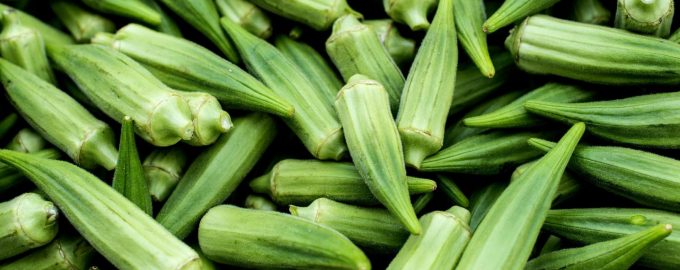Looking for a new shade of green to incorporate into your diet? Meet okra: it’s the fancier, more tender string bean that’s packed with fiber and adds a flavorful crunch and pop to whatever it’s added to.
Sure, if you’re besties with Tom Colicchio, you might be skeptical about okra’s texture, but once you know how to prep it, you’ll wonder how you were living without it for so long.
Read on to answer your burning questions about okra (including how not to burn your okra) and why its health benefits make it well worth getting to know:
What is okra and how does it taste?
Like the sneaky tomato or the misunderstood avocado, okra is a fruit that often masquerades as a veggie. The long, green tubers contain some seriously juicy seeds inside and have an earthy, fresh taste. “Okra is the fruit of a plant in the mallow family and is a cousin of the marshmallow root plant,” says nutritionist Brooke Scheller, DCN, CNS. This group of plants is known for producing a mucilaginous, or a gel-like texture, which is why if you’ve tried okra before, you might remember it as a little slippery or slimy. But when prepared properly, okra can produce a satisfying crunch.
If you’re wondering what okra tastes like before you jump in, it’s commonly compared to the green bean. Okra tends to have a mild flavor that some describe as slightly grassy, while others compare it to the common green bean or even eggplant. Its texture is where it differs the most from these two vegetables.
How nutritious is okra?
Okra’s nutrition facts are impressive, but don’t reveal all the nutritional value of this under-appreciated fruit. You’ll get 3g fiber in just one cup, which totals a mere 33 calories. But it’s the vitamin and mineral content of this fruit that’s truly impressive. One cup of okra delivers 14% of your daily vitamin A needs, 26% of your daily vitamin C, 26% of your daily vitamin K, and 14% of your daily vitamin B6. You’ll also get 14% of your daily magnesium and 15% of your daily folate with the same one-cup serving. It’s also a sneaky source of plant-based protein, delivering 2g per cup. That’s why okra finds its way into our Freshly meals: With its low calorie content, it’s surprisingly high in nutrients that help you feel and perform your best.
What are the health benefits of okra?
It’s clear that okra packs a lot into a small package. But it’s also worth highlighting why the specific nutrients in okra are so impressive, and important. From antioxidants to folate, here’s what okra’s nutrients are actually doing for you and your body.
May help combat free radicals
Okra is a functional food packed with antioxidants. Though we make some antioxidants naturally, we need them in the right quantities to help balance free radicals in our body. Free radicals are created naturally by processes in our bodies, but without antioxidants to balance them can cause cellular damage known as oxidative damage. The state of these two being imbalanced in our bodies is called oxidative stress. This condition damages cells and has been linked to several chronic diseases such as diabetes, heart disease, certain cancers, and neurodegenerative diseases (like Alzheimer’s disease and Parkinson’s disease).
Oxidative stress is also linked to aging. It’s less important than reducing your risk of chronic diseases, but lowering oxidative stress in your body may also reduce your chances of developing premature aging of the skin, which shows up as fine lines and wrinkles. This imbalance does that because it causes inflammation and aging of our skin. Luckily, we can bring antioxidants and free radicals back into equilibrium through dietary intake of antioxidants–and okra is one food source of these vital nutrients.
May improve your heart health
Your heart can benefit from this reduction in oxidative stress, too. Eating a diet high in polyphenols, one type of antioxidant, has been shown to improve your heart health by lowering your risk of blood clots. Additionally, okra may lower your risk of heart disease. High cholesterol is just one risk factor for heart disease, but okra may help: That thick gel-like substance that some people find so objectionable in this fruit is called mucilage. You may not enjoy the mouthfeel of this substance, but it can actually bind to cholesterol during digestion. Animal studies have shown that okra powder can lower cholesterol levels by binding with these fats during digestion. Once they’re bound, they’re eliminated from the body through stool.
That’s not the only way it can help lower cholesterol, either. Okra is particularly high in soluble fiber. This specific type of fiber has been shown to lower blood cholesterol. There’s only one problem: most Americans don’t hit the recommended dietary allowance (RDA) of fiber in general. Adding okra to recipes to bulk out your meals or add a different texture to salads is an easy way to get closer to meeting your daily fiber needs. For men between the ages of 19 and 50 that’s 38g of fiber a day. For women in the same age group, it’s 25g per day.
May help keep your gut healthy
The science of gut health is trendy, but there’s a lot researchers still don’t know. What is becoming clear is that gut health impacts a wide range of the systems in our bodies, from our mental health to our metabolic health. But our guts contain both “good” and “bad” bacteria. The key is to feed the good bacteria so that the balance of bacteria in your gut, referred to as your gut microbiome, is one that supports health benefits. Okra has been found to have the right kind and right amount of fiber to be considered a prebiotic, a type of food for your “good” bacteria.
May benefit pregnant women
Pregnant and breastfeeding women have higher folate needs than the average adult. Folate is important for everyone; deficiencies in this critical nutrient are associated with higher rates of certain types of cancers, including colorectal, prostate, and breast cancer. But pregnant women need more because folate is important for fetal development as it’s essential for the formation of an essential amino acid. Getting enough folate during pregnancy helps reduce the risk of developmental issues like neural tube defects (such as spina bifida) and congenital problems such as congenital heart defects and cleft lip.
Where can you find okra?
You can buy okra at most well-stocked grocery stories. Big box stores keep canned or jarred okra stocked, though Scheller recommends reading the label as canned or jarred okra may use chemical preservatives and even be a source of hidden sugar. You can also buy okra frozen, which is a great way to store it for longer periods of time.
How to cook okra
Okra can be boiled, blanched, fried, sautéed, or steamed and is even tasty raw. You can prepare it whole, which preserves the earthy syrup inside or slice it into discs, giving more texture and thickness to your dish. If you’re less keen on the texture, try steaming or blanching okra for 3-4 minutes, then dry it before you add it to your meal to minimize the slime.
You can also lessen the slimy texture by making fried okra. Flash frying okra will make it crunchier than slimy, but if you’re not equipped to do that at home, you can also make air fryer okra or oven-fried okra. If you’re cooking okra in a pan, the trick is to use high heat. Cooking the pods at a low heat for a longer amount of time brings out the slimy factor. You’re more likely to get slightly al dente okra with a crunch using a hotter pan. Our Freshly chefs use similar techniques to make sure you’re getting okra at its most delicious in our meals.
How can you use okra to make healthy meals?
You’ve already seen that okra’s nutrition is impressive—it’s one healthy fruit. But the key to incorporating it into healthy meals is to not counter all its benefits with calorie- and sugar-laden sauces and toppings. You can also use okra to give meals a heft that keeps you full for hours without weighing you down, thanks to its low calorie count and high fiber content.
Try a stir-fry
Okra adds crunch to an Asian-style stir-fry. And bonus: sliced, it has a star-like shape that makes any dish look at least 15 percent fancier. Add the pods toward the end of the recipe to avoid overcooking them and activating the sliminess.
Keep it simple
If you’re eating it raw, okra makes a crisp addition to a veggie platter tray and elevates your dish from appetizer to conversation starter. Pair it with a greek-yogurt based dip for a protein punch. You can also slice it and add it to your salad for extra fiber and texture if you’re skeptical of noshing on it solo.
Up your soup-game
Because of its viscous texture and high fiber content, it does wonders for thickening soups and stew, like in our Andouille & Chicken Gumbo with dirty rice & veggies.






